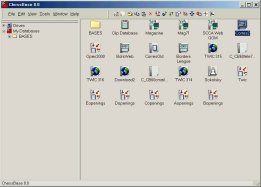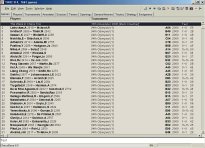 |
ChessBase Reviews |
Last updated 2 December 2000

| index | part 1 | part 2 | part 3 | part 4 | part 5 | part 6 | part 7 | part 8 |
ChessBase 8 Part 1
ChessBase 8 has now been released and I am pleased to announce that my favourite chess software has just become even better. There are a great many improvements so I will be covering them in a series of articles. In this one I will describe the graphical and interface improvements.
I must be honest though. When I first installed CB8 I had my doubts. My first reaction was that I would stick to using ChessBase 7. Not because it looked bad, it actually looked superb, but because I found it slightly difficult to use compared to the previous version. The new version is easier to use, but I was just used to the way things were done in CB7.
New users won't have this problem. Simple things were catching me out. Quite simply it was a case of having to learn how to do certain things, and that takes time and effort. A week into using the program and I have no plans to go back.
For example, in CB7 if I had a game loaded and amended it, I would replace the game by selecting the Game tab and then Replace. In CB8 I have to select the File tab and then Replace. Later I discovered that at the top of the game window one of the button icons is actually Replace, so I could simply click on that. There is a lot to be said for reading the Manual before you start playing around with things. Personally I prefer a hands-on approach as I tend to find that I then remember how things are done much more easily. I wouldn't recommend this approach as reading the manual is generally quicker. The ChessBase site also has a superb online manual for CB8 which goes into great detail on how to use the software.
So was the time and effort of learning the new software worth it? I think so, but to answer that question you have to decide if any improvements outweigh the effort of getting accustomed with the new layout. So what are the improvements and changes? I counted over 20 listed by ChessBase and you will be learning about more of these in future articles. Here are a few to whet your appetite.
The first point to note is the price. At the time of writing this the basic package is retailing at about £99.95 in the UK, which is a lot cheaper than CB7 was when it was first launched. If you shop around you might even find better deals, particularly if you are only upgrading from ChessBase 7. Quite simply it is superb value for money and should put CB8 well within the price range of a lot more players.
Cost aside, the first improvement you notice is the layout. CB8 has been redesigned from the ground up and is much nicer in appearance. The interface looks and feels pretty much like a Windows operating system which makes it much more intuitively easier to use because just about everyone will be used to Windows.
Databases and folders are laid out in a hierarchical fashion which mirrors your own directory structure. I have taken some screen dumps to help illustrate the various windows that appear.
The first Window to appear when you launch CB8 is the database window.
 The right hand side displays folders for the databases that you normally use. Those of you who previously used CB7 will
see your normal databases there when you first launch CB8. These can be added to or removed from the front screen as you wish.
Don't worry about accidentally deleting an actual database since CB8 now sends deleted files to the recycle bin, so if you do
make a drastic mistake you can always recover them (assuming you are not one of those people who has disabled the recycle bin).
The right hand side displays folders for the databases that you normally use. Those of you who previously used CB7 will
see your normal databases there when you first launch CB8. These can be added to or removed from the front screen as you wish.
Don't worry about accidentally deleting an actual database since CB8 now sends deleted files to the recycle bin, so if you do
make a drastic mistake you can always recover them (assuming you are not one of those people who has disabled the recycle bin).
The left hand side of the screen has a Windows style explorer bar which makes it very easy to navigate around you hard drives to find databases, wherever they are stored.
Double clicking on one of the databases on the right will open a separate window with a standard list of the games contained in that database.
Double clicking on any of the games launches another window with that game loaded. This window looks significantly different from what you would have seen in CB7, and is a perfect example of the improved graphics interface that CB8 uses.


I have included all of the panes that you might normally use. Game Moves, Player Pictures, Board, Analysis Engine and Analysis Engine Best Line Board. Of course you can switch off any of the panes that you don't want to use. Each pane can be resized to suit your own tastes and indeed can also be placed in different positions on the screen as you see fit. For example you may want the main board smaller and the analysis pane larger.
When you move the individual panes to different places on the screen they automatically lock into place so there is no danger of accidentally obscuring another window. In fact once you have set the screen up the way you want it you can save that configuration for future use. You can also see that the Windows taskbar at the bottom shows the three main ChessBase windows that are currently opened. This means that you can easily access any of them by clicking on it in the taskbar to bring it to the front.
The design of the Board can also be changed to a number of different styles. So, for example, if you prefer an elegant wood board then you simply select that. There is even an option to use a 3D board. You will notice that I have the arrow buttons for playing through the game, below the board. By default these weren't there the first time I used CB8. These buttons are in the Icon tray above the other windows. I had to do some searching about to find out how to also have them where I am used to seeing them.
The best analysis line board is one of the fine additional graphics details of CB8. It looks rather small in the above picture but remember you can resize windows at will. This analysis board allows you to play through the moves of the currently calculated best line, found by the analysis engine that you are using, without changing the position on the main board.
So, from the points listed already, I would recommend ChessBase 8 to anyone, and there is still a lot more to cover in the coming articles.